| Author |
Message |
    
handyjc1
New member
Username: handyjc1
Post Number: 1
Registered: 08-2004
| | Posted on Thursday, August 19, 2004 - 10:39 pm: | 




|
When I wad a kid my dad had a small step hydroplane powered by a 3 cyl 25 hp 2 stroke Pierce Budd engine. Separate brass covered cylinders and two updraft carbs, one on each side of the engine. The only reference I have been able to find on the net is a 1912 Mullins boat powered by this engine. I need any and all history that anyone may have on this engine. Please e-mail or post. Do any exist?
Thanks in advance, John Handy |
    
Scott Peters
Visitor
| | Posted on Monday, August 23, 2004 - 08:44 am: | 




|
Pierce-Budd was based out of Bay City, Michigan and was previously known a Pierce, Nye & Budd. Bay County Historical Museum in Bay City might have catalogs. The company was located at 205-209 Saginaw Street in Bay City and was incorporated in 1910 with a capital of $5,000. Officers of the firm included James H. Pierce, president; Reuben Bastow, vice-president; F. H. Newcomer, secretary; and Anna S. Pierce, treasurer. Pierce was formerly superintendent and designer of the Smalley engine. Overall, I believe they specialized in racing engines.
Source: R. L. Polk & Co. Polk's 1913 Bay City Directory (Bay City/Detroit, MI: R. L. Polk & Co., 1913.) pp. 51, 158, 665-666.
Hope this helps. |
    
modhydro
Member
Username: modhydro
Post Number: 4
Registered: 08-2004
| | Posted on Monday, August 23, 2004 - 02:07 pm: | 




|
I have a 1922 Hacker designed hydroplane that specified the Pierce-Budd as the powerplant. I have a 1925 magazine article that says they were still around then also, but it sounds like they were about done by then. Not a lot of info, but a little bit more. |
    
Steve Fox
Visitor
| | Posted on Sunday, August 29, 2004 - 10:43 pm: | 




|
Yes, such an engine does exist. I have seen one. Who and where is classified, however I certainly enquired whether it was for sale- it was already spoken for, alas. It is an interesting engine. This was an early one- I would say about 1910-1911. The engine has brass water jackets and a very small aluminum crankcase. Each cylinder has its own carburetor and manifold, but only on one side. It's very lightly built and probably weighs less than 200 lbs for the whole unit. |
    
richarddurgee
Senior Member
Username: richarddurgee
Post Number: 540
Registered: 11-2001

| | Posted on Sunday, August 29, 2004 - 11:14 pm: | 




|
Chesapeake Bay Maritime Museum
St Michaels, MD
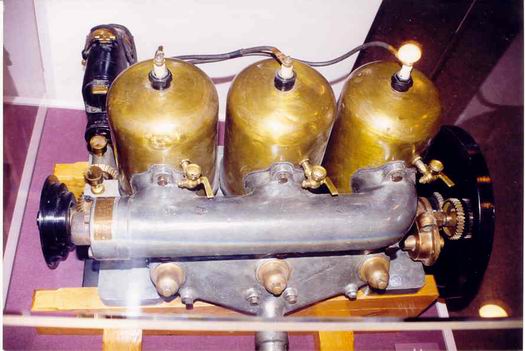
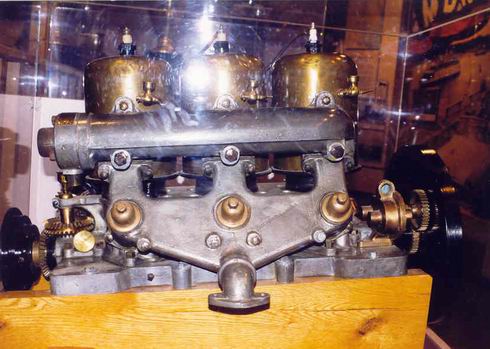 |
    
bruce
Senior Member
Username: bruce
Post Number: 213
Registered: 07-2002
| | Posted on Monday, August 30, 2004 - 09:33 pm: | 




|
Nice full page Pierce-Budd ad on page 165 in Engines Afloat Vol#1. Available as a 6cyl- imagine the sound of that baby!!235 # in the three cyl format producing 25HP @~1800 RPM. 2/3 port with fuel available at each at each location. High speed model with Bosch 3 cyl mag(DU-3?)Ad date 1922.A 3cyl heavy duty model weighed 360#; put out 20HP at 1200 rpm and sported an Atwater Kent ignition system. Sometimes refered to as the "Brass Bound Bastards ; the Engine company started life in Merrill Mi. west of Saginaw and South of Bay City. Mine compliments of Mr Bill Wolfe a while back- thanks once again Bill!! |
    
Bruce Ward
Visitor
| | Posted on Saturday, December 27, 2008 - 05:47 pm: | 




|
I have here in Australia the remains of a Pierce Budd engine. My father used it in the early 30's. The twin plug 3 cyl. Bosch magneto was stolen after the war years. Is any person interested in the various parts. I just happened to have come across this site. |
    
paul mercuri
Visitor
| | Posted on Sunday, June 21, 2009 - 03:02 am: | 




|
PIERCE-BUDD ENGINE visit http://silverstreakhydroplane.googlepages.com/home} |
    
modhydro
Member
Username: modhydro
Post Number: 12
Registered: 08-2004
| | Posted on Sunday, June 21, 2009 - 08:37 am: | 




|
Bruce Ward,
Please get with me about the engines. I have e-mailed a response to your note the other day and haven't heard back. Maybe your spam filter caught it or something.
Thanks
Steve |
    
modhydro
Member
Username: modhydro
Post Number: 13
Registered: 08-2004
| | Posted on Tuesday, August 18, 2009 - 03:24 pm: | 




|
Two neat projects just hit the US. After a while of messages back and forth between myself and Bruce all the way in Australia, and a long boat trip across the Pacific, I am lucky enough to have a pair of Pierce Budds. One actually has dual ignition. They are rough and I will have to get several parts cast, but are very neat engines and have great potential to be made into runners again. I'd rate the parts at around 80% good as they sit from a quick inspection. Now all I need is to find a couple of 3 cylinder mags. The dual ignition one will be a trick to find I'm sure.
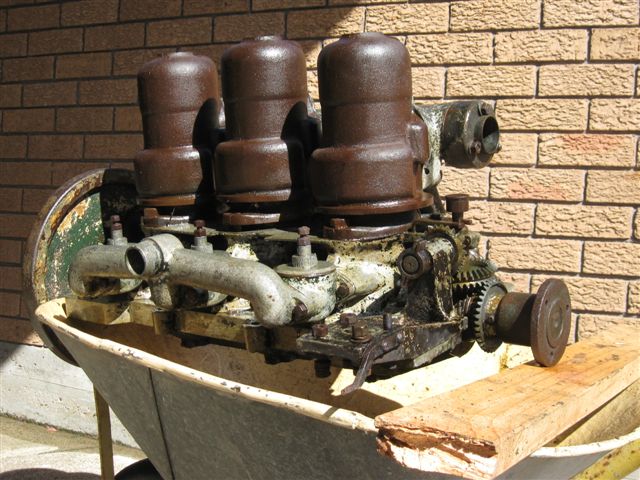
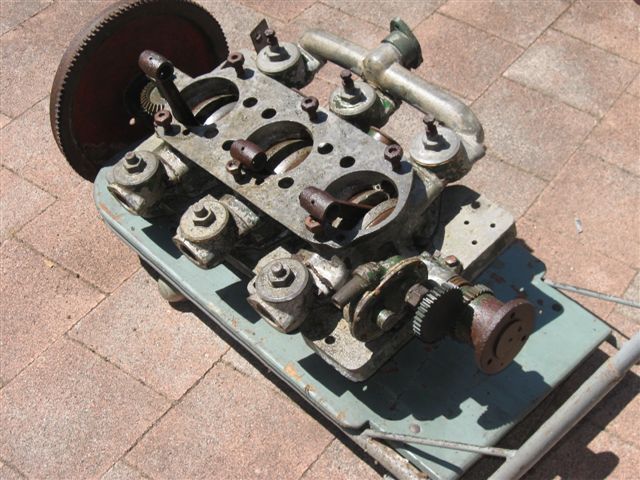 |
    
richardday
Senior Member
Username: richardday
Post Number: 786
Registered: 11-2003

| | Posted on Tuesday, August 18, 2009 - 04:42 pm: | 




|
Probably the most significant advancement made in the evolution of the two-cycle engine was the mixing of oil in the gasoline fuel supply to solve the engine lubrication problem. The earliest reference to this "daring innovation" appears to be an article on page 179 of the April 1909 Power Boating Magazine. It appears that Mssrs. Pierce, Nye and Budd were the originators of the practice.
These gentlman were winning all the races at that time for engines in that class. Other makers quickly picked up the practice and soon two cycle engines were no longer fes-tooned with drip oilers and lubricators. |
    
gregoryan
Advanced Member
Username: gregoryan
Post Number: 42
Registered: 09-2004

| | Posted on Tuesday, August 18, 2009 - 07:22 pm: | 




|
Thanks for photographing - - great to see inside of different engines! With the water-jacket off we can see the bulge of the transfer ducts & the start of the exhaust ports. Its a shame so many engines had water cavities that were inaccessible, as the cylinder & head are often one-piece. A removable head allows some cleaning access.
Only 2 holding--down studs on each barrel!
The other pic shows the crankshaft has full bob-weighted webs, rather than simple forgings. |
    
modhydro
Member
Username: modhydro
Post Number: 14
Registered: 08-2004
| | Posted on Wednesday, August 19, 2009 - 08:42 am: | 




|
I will get more photos once I get deeper into the project. The crankshaft actually stuffs the crankcase very fully. It is similar to the full circle crankshafts in modern hi-perfomance 2 strokes. This surprised me in something so early. The web fillers are largely aluminum as well, so I don't think the intent was totally counterweight for balance. |
    
searcher
Senior Member
Username: searcher
Post Number: 325
Registered: 10-2004
| | Posted on Wednesday, August 19, 2009 - 08:56 am: | 




|
Here is the article mentioned by Dick Day regarding mixing oil with the gasolene.
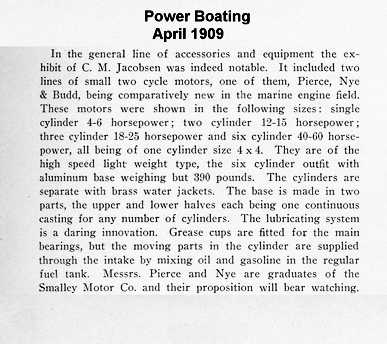 |
    
searcher
Senior Member
Username: searcher
Post Number: 327
Registered: 10-2004
| | Posted on Thursday, August 20, 2009 - 10:15 am: | 




|
Here is a 6 cyl. Pierce, Nye, and Budd. What a sight it must have been to behold with all those brass water jackets and grease cups polished up and a factory fresh coat of paint. Oh, to hear it run.
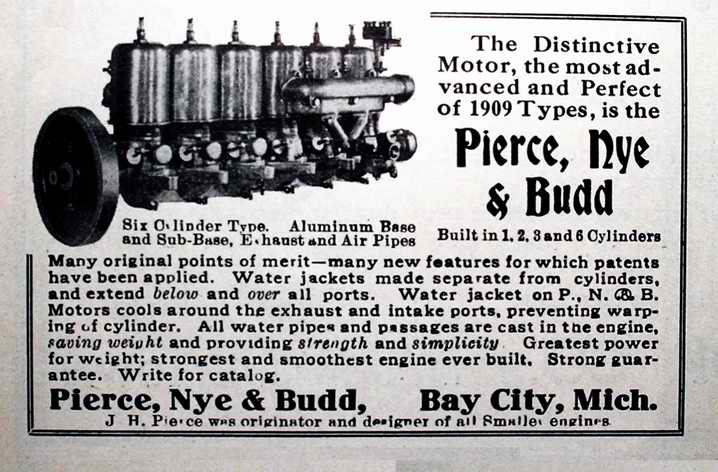 |
    
gregoryan
Advanced Member
Username: gregoryan
Post Number: 43
Registered: 09-2004

| | Posted on Thursday, August 20, 2009 - 08:46 pm: | 




|
Six Cyl 2 Stroke! WoW! 4"x4" = 824cc per cyl, x 6 = 4943cc Thats a lot bigger than the average 6cyl car.
Rated at 40- 60HP, i wonder what revs & prop size!? |
    
boyd_guard
Member
Username: boyd_guard
Post Number: 17
Registered: 06-2005
| | Posted on Friday, August 21, 2009 - 06:33 pm: | 




|
The aluminium parts of these engines have lasted well, in my early boating days, 1940`s, we coated the ali sumps with pitch as bilge water was allways present and the aluimiuum was eaten out.
Nice grey wheel barrow, have one the same and it has been a moveable trolley for many old engines. |
    
todd_vidgen
Senior Member
Username: todd_vidgen
Post Number: 134
Registered: 03-2008
| | Posted on Sunday, August 23, 2009 - 06:14 pm: | 




|
Nice Motors,I might note that wheel barrows dont do the crank shafts much good when supported on
the extreme ends like that,Blaxlands especially
with their little 1 inch dia cranks |
    
boyd_guard
Member
Username: boyd_guard
Post Number: 18
Registered: 06-2005
| | Posted on Sunday, August 23, 2009 - 09:43 pm: | 




|
I agree with you Todd, wheel barrows and other contrivances that eng owners move their engs. on should have eng. beds to support the eng. |
    
modhydro
Member
Username: modhydro
Post Number: 15
Registered: 08-2004
| | Posted on Monday, August 24, 2009 - 02:48 pm: | 




|
I'm pretty sure that it wasn't on the wheelbarrow that long. That is how Bruce moved them from who knows how many years of storage to get me some photos. When he shipped them, they were actually bolted to engine beds in the crate. I doubt that new engines have as much care put into packaging.
I'm thankful that they were on the wheelbarrow for photos and not a trip to the dump! Thanks to this site and the power of the internet, two neat old engines will be made to run again.
Steve |
    
todd_vidgen
Senior Member
Username: todd_vidgen
Post Number: 135
Registered: 03-2008
| | Posted on Monday, August 24, 2009 - 05:36 pm: | 




|
Its not so much the length of time,its all the little bumps that the barrow goes over when moved,
as the weight of the engine thumps on the end of the crank.ie would you tap the end of the crank
with a 200lb sledge hammer.I bought this up because it is something a lot of people dont realise,and
my friend and I have had to straighten a number
of cranks and can take a bit of time to correct them.It will a least save you one less job to do
on what will be a very worth while project
Regards Todd |
    
champ
New member
Username: champ
Post Number: 1
Registered: 08-2014
| | Posted on Tuesday, August 19, 2014 - 11:46 pm: | 




|
I just acquired a Pierce Budd that I plan to re-build and hope to make it run. Any sources of information, or components is greatly welcomed! This just looks like a cool old engine!
Thanks in advance...
Champ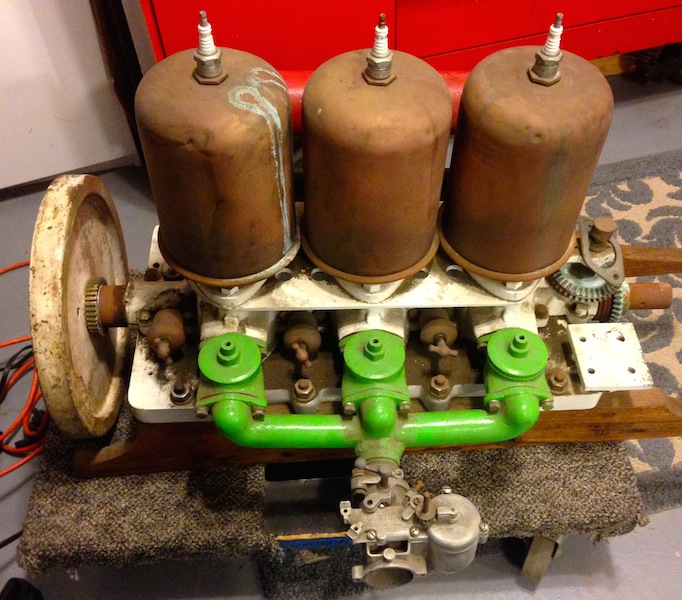 |


